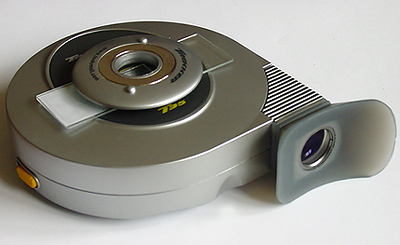
Microscopy
on the move:
A look at the Trekker field microscope
by David Walker, UK
|
|
Microscopy
on the move: by David Walker, UK |
The Trekker microscope I believe has been available for some time and retails in the UK shops and online for ca. £49. On UK eBay recently, a seller was regularly offering them new for as little as £29 (if a first bid secures) so decided to buy one at this very appealing price to try it out myself. The maker's website is www.looksmall.com and gives a good overview of its specs, the rationale for its mag and design, typical uses, accessories as well as an image gallery.
Essential
features from maker's specs:
Fixed mag 35x. Nine element coated
glass optics.
Annular LED illumination
for incident lighting.
Ambient lighting above unit required for transmitted
lighting.
The eyepiece is removable to be used as a standalone 10x hand
lens.
Square field of view.
The maker's note on their website that it was designed by Rick Dickinson who also designed the 'palm microscopes' that predate this model (ref. 1), i.e. the Lensman (80x / 200x, see Mike Dingley's Micscape review) and more recently the Micron Pro 160 (80x / 160x). The Meade Readiview is also available which seems to share specs and styling with the Micron.
My own 'test hike' of the Trekker is summarised below and should note that I haven't previously used or handled the other models of this design but am familiar with the Open University (UK) McArthur style microscope and Moticam DigiScope series and a great enthusiast of hand lenses.
Out of the box:
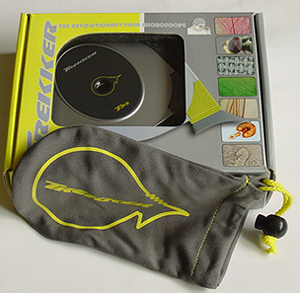
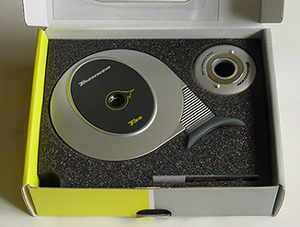
The
microscope is very attractively presented and includes a carrying pouch, two
prepared slides,
a ground cavity slide and magnetic clamp to hold specimens.
Also 9V PP3 battery.
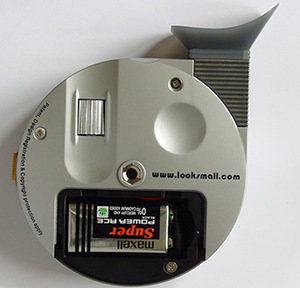
Underneath,
is a sturdy metal tripod bush, also seen is the focussing knob and open battery
compartment.
The LED switch can be seen on left hand side. The dimple is
useful when holding.
|
Curiosity killed the cat so the saying goes, but not the curious microscopist, not to date at least. So it wasn't long before the top was off to see how it worked. This is easy as three screws hold the two halves together. It's ca. 10.2 cm wide and 2.5 cm thick. M - three plane mirrors. The central one is at 45 degrees to the plane of monitor and faces the glass plate in cover. LED - the battery powered LED lamp illuminates one side of a plastic annulus in top to give off-axis lighting for opaque subjects. E/P - the eyepiece is removable as it's mounted on a plastic dovetail. The three elements are sturdy well ground coated lenses. The eyepiece cowling is only held together by a rubber ring and eyecup, so allows cleaning. Although in the author's example the square lens is not well secured and rattles quite noticeably in the housing. L - the lens unit is focussable on the brown metal rail. The focussing wheel acts on it. The maker's state it is a nine element microscope, so counting the mirrors this suggests the lens unit L is a triplet. The 'folded optics' design is elegant and looks robust. If it every suffered a thorough dunking in mud or salt water, a user could take the top off and clean down readily. |
Microscope in use:
Transmitted light - unlike the Micron / Readiview, the Trekker does not have built-in transmitted illumination. For outdoor use a bright sky away from direct sun gives a well lit view. The Trekker gave less bright images in the author's lounge which has good natural light and white ceiling, so if using indoors the ambient lighting may need supplementing. Lateral movements are reversed i.e. moving subject left moves the image to the right. The field of view is ca. 4.5 x 4.5 mm.
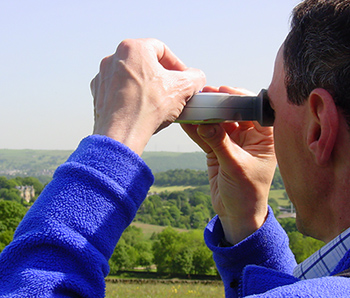
The
Trekker in use by Ian Walker in the Pennine hills.
The maker's website shows youngsters studying a whole daffodil flower and large plant parts with the Trekker but I don't think it is very suitable for larger three dimensional subjects. At 35x the depth of field is inevitably quite shallow (<1 mm) so works best when a subject is flattish e.g. leaf, stem, or if a larger subject it could be prepared to present a thinner and flatter plane, e.g. by cutting a flower head in half or items removed like stamens and sat on a microscope slide to study.
Prepared microscope slides can be securely held by the magnetic ring and 35x gives good overviews of many larger prepared subjects such as insect parts, plant stem sections. As the maker's note it can focus to ca. 17 mm above the unit so a well slide with pond water can be upright and focussed through the water. Aquatic invertebrates like water fleas, shrimps and hydra can be enjoyed in some detail at this mag. Smaller live land invertebrates could also be temporarily immobilised in small vessels and studied. The maker's note in the instruction leaflet that focus can be fixed at a good distance and objects moved in the plane of focus to study.
Incident light - The built-in LED gives bright, white lighting via the annular ring to suit opaque and semi-opaque subjects that will reflect light. The off-axis lighting gives good modelling and images of coins, textiles, paper, leaf surfaces etc are pleasing. The magnetic ring works well to secure flat objects like paper, leaves, textiles etc.
Photography - A 'Photo Link' and 'Digital Link' are available to couple the Micron Pro 160 to an SLR camera or suitable digicam so these couplings may work with the Trekker. I haven't studied this aspect but the maker's website image gallery if taken with the microscope show good images. I can't think of many easy ways of taking images at 35x in the field so this compact approach could be useful where required but may need a fast film / sensitive camera.
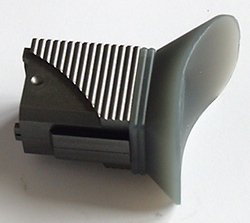 Eyepiece
as 10x hand lens: The eyepiece when removed is a nice size for a hand lens
and the eyecup is a bonus. The square field is rather neat and gives a
bright contrasty view from the glass triplet (see internal shot above).
The field of view is ca. 16 x 16 mm and fairly flat.
Eyepiece
as 10x hand lens: The eyepiece when removed is a nice size for a hand lens
and the eyecup is a bonus. The square field is rather neat and gives a
bright contrasty view from the glass triplet (see internal shot above).
The field of view is ca. 16 x 16 mm and fairly flat.
Unfortunately its versatility is limited by its short working distance of ca. 2 mm; perhaps this is an inevitable consequence for how it needs to act in its primary role in the microscope. It works well for e.g. inspecting a prepared glass microscope slide (small plastic pegs allow the eyepiece to sit on flat subjects at the correct distance) but if studying three dimensional objects, parts of the subject are often touching the lens and found myself frequently cleaning the exposed element. Also, if the subject covers most or all of the field it has to be transparent or translucent as the working distance doesn't allow sufficient incident light to study opaque objects as a typical hand lens would.
Conclusion: This is an elegantly designed microscope, genuinely pocketable and gives informative images of suitable subjects. It's also good value at its discounted price of ca. £30. The 35x mag would perhaps best suit a naturalist seeking a higher mag than a hand lens can offer to study the smaller features of fauna and flora critical to identification in the field e.g. leaf hairs, smaller insect features etc. It's also useful for studying aspects of smaller aquatic and land invertebrates.
At it's full price of ca. £50 - £60 I think other microscopes in this price bracket work better if true pocketability isn't that important and particularly if indoor work is its major planned use. The 20x monocular microscope recommended by the Royal Microscopical Society and others for primary school use is easier to use for unprepared specimens, particularly for the young and less dexterous. If mainly studying prepared or temporary slides a small student compound microscope with 4x objective would be worth considering. These are bulkier microscopes but can fit in a rucksack and with planning can also be used outdoors.
The Trekker is less suitable for more general studies of fauna and flora in the field where the lower power of a 5x - 10x hand lens with its greater depth of field, field of view and more intuitive use would be better. Field studies with this sort of mag can reveal a surprising amount. The Trekker's eyepiece does act as a 10x lens and is a useful feature, although as commented above, its short operating distance makes it a less versatile hand lens than a dedicated one.
Comments to the author David Walker are welcomed.
References.
1)
'A catalogue of portable microscopes' on CDROM, 2002, by Mike Dingley. This
has entries for Science of Cambridge's Lensman and Enhelion's Micron.
Published in the June 2005 edition of Micscape.
Please report any Web problems or offer general comments to the Micscape Editor .
Micscape is the on-line monthly magazine of the Microscopy UK web site at Microscopy-UK
© Onview.net Ltd, Microscopy-UK, and all contributors 1995
onwards. All rights reserved.
Main site is
at www.microscopy-uk.org.uk
with full mirror
at www.microscopy-uk.net
.